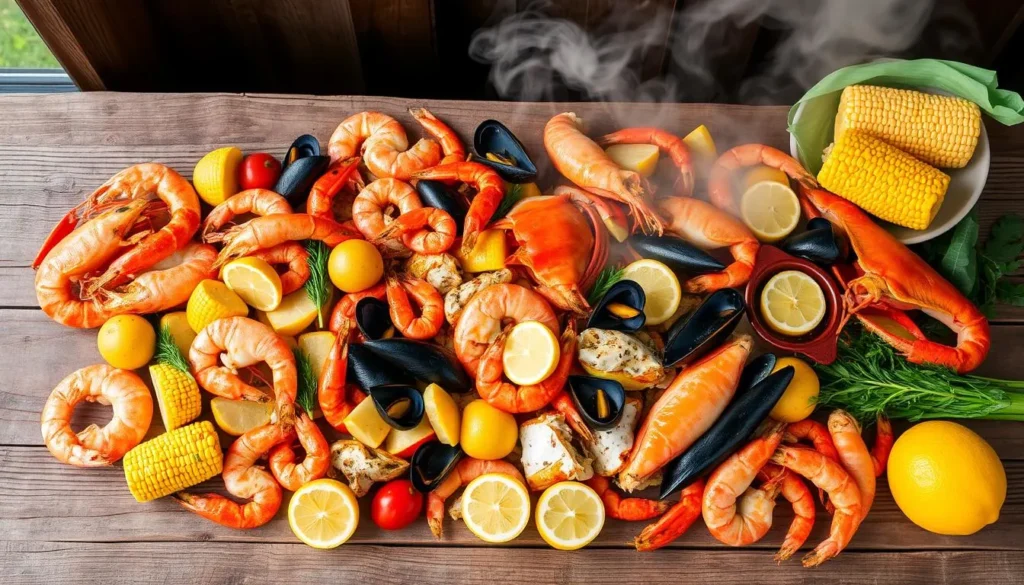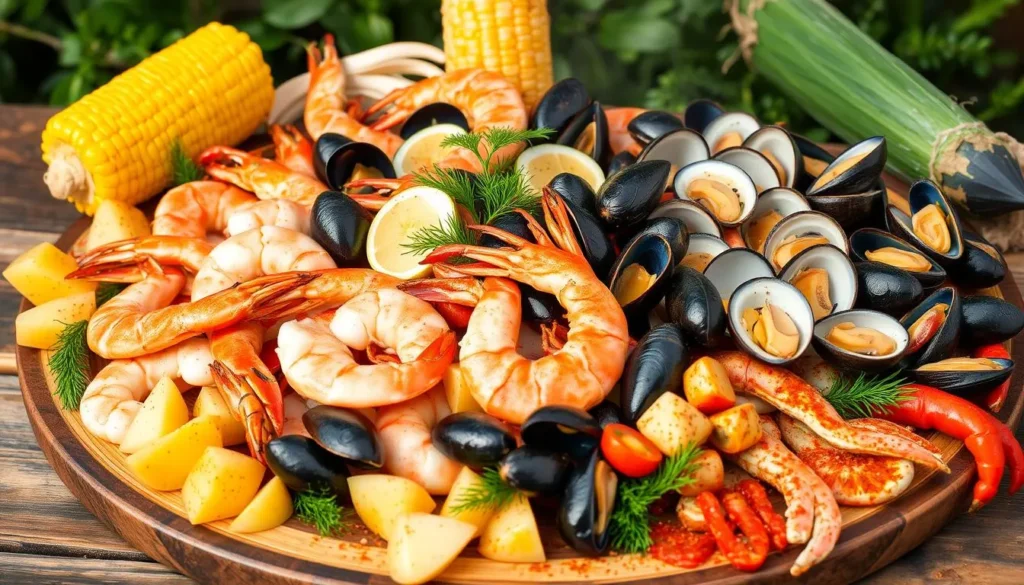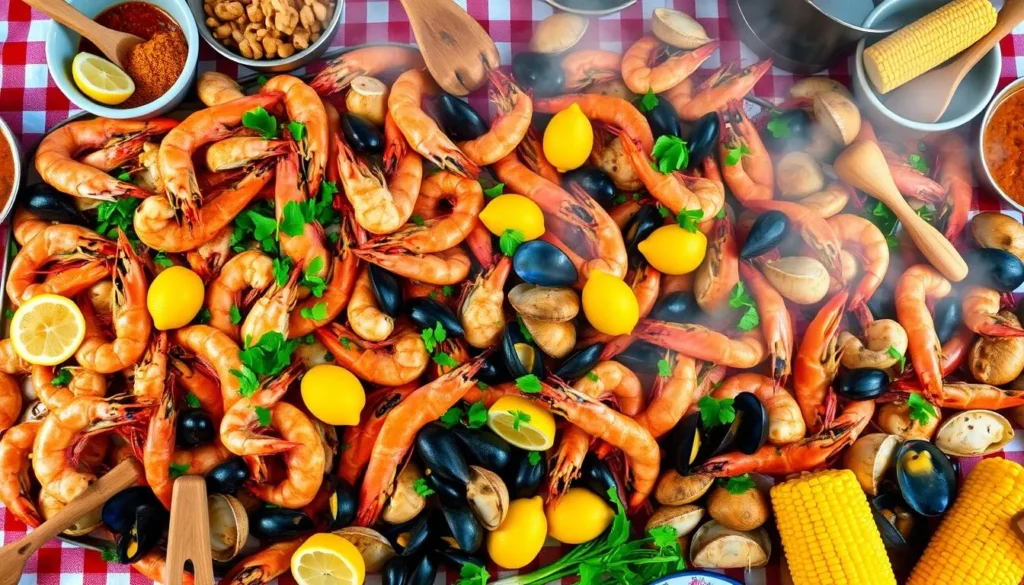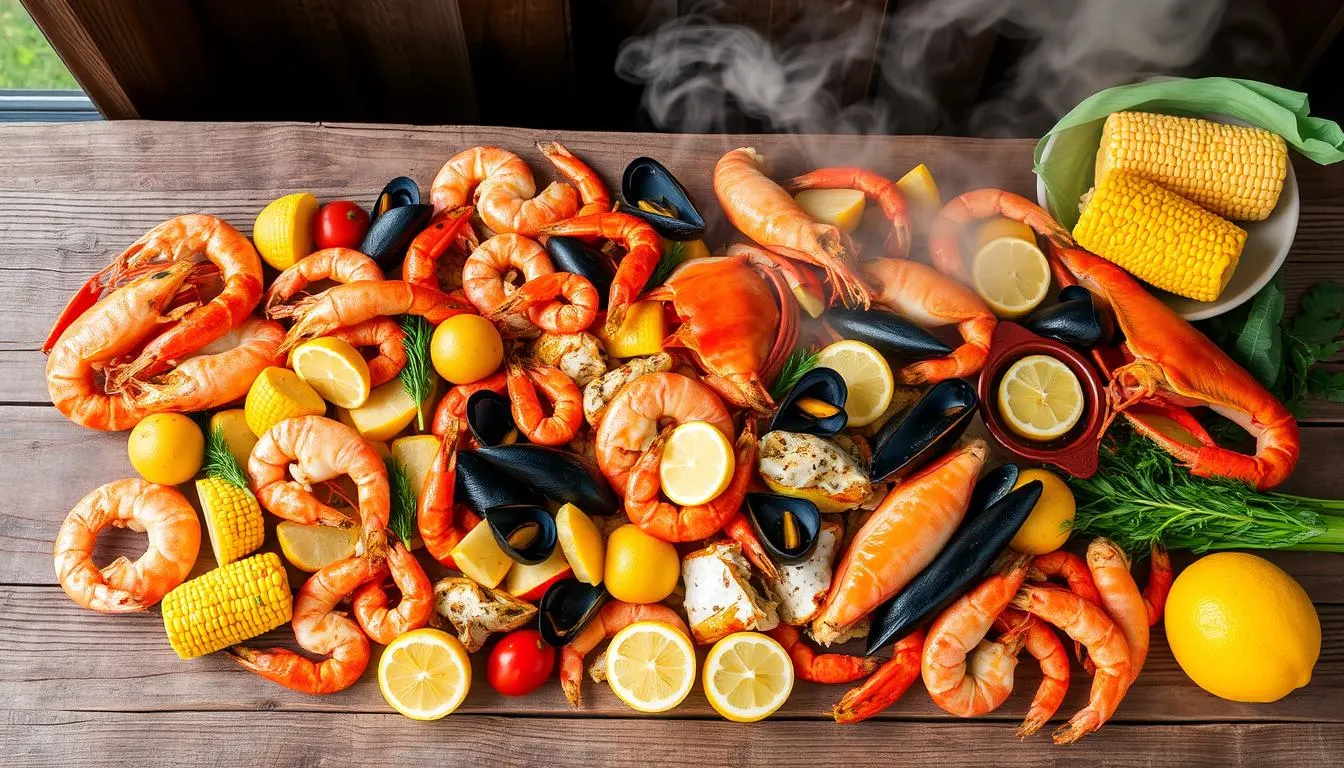I love seafood and the fun of a seafood boil. It’s full of colors, tastes, and brings people together. But, is it good for us? Let’s explore the health benefits and what to watch out for in seafood boils.
Related : Delicious Seafood Boil Sauce Recipe You’ll Love

Key Takeaways
- Seafood boils are a traditional and flavorful culinary experience, with deep cultural roots.
- The nutritional profile of seafood boils can be quite diverse, depending on the specific ingredients used.
- Seafood, the star of the boil, is an excellent source of high-quality protein, essential vitamins, and heart-healthy omega-3 fatty acids.
- Preparation methods and portion control play a crucial role in determining the overall healthiness of a seafood boil.
- With some mindful adjustments, seafood boils can be enjoyed as part of a balanced and nutritious diet.
Understanding Seafood Boil: A Culinary Tradition
Seafood boils are a beloved tradition in the United States. They bring together fresh seafood and traditional ingredients. This celebration honors the region’s bounty and unique flavors.
Origins and Cultural Significance
The seafood boil tradition started with coastal indigenous people. They cooked seafood in large pots. Over time, settlers along the shores added their own touches.
Today, seafood boils are a big deal in coastal communities. They bring people together. Sharing a meal celebrates local traditions and cultural heritage.
Common Ingredients in Traditional Seafood Boils
Seafood boils are all about fresh, local ingredients. They give the dish its special taste. Common items include:
- Shrimp
- Crab
- Lobster
- Crawfish
- Potatoes
- Corn on the cob
- Sausage
- Onions
- Garlic
- Spices and seasonings

“Seafood boils are more than just a meal; they’re a celebration of community, tradition, and the bounty of the sea.”
The heart of seafood boils stays the same, even as ingredients change. They offer a taste of local culture and a sense of belonging.
Is Seafood Boil Healthy? A Comprehensive Analysis
Seafood boils are a tradition from coastal communities. They mix flavors and offer nutritional benefits. But, they also have health concerns to look at.
The nutritional profile of seafood boil ingredients is key. Seafood, vegetables, and spices all add to the dish’s healthiness.
| Ingredient | Nutritional Highlights |
|---|---|
| Shrimp | High in protein, low in calories, and rich in essential vitamins and minerals like selenium and vitamin B12. |
| Crab | An excellent source of protein, zinc, and vitamin B12, important for immune function and red blood cell production. |
| Corn | Provides dietary fiber, vitamins, and antioxidants like lutein and zeaxanthin, which support eye health. |
| Potatoes | Offer complex carbohydrates, fiber, and various micronutrients, including vitamin C and potassium. |
The cooking methods in seafood boils also matter. Butter, oil, and high-sodium seasonings can add calories and sodium. This might reduce some health benefits.
To understand if seafood boil is healthy, we must look at both sides. This way, people can make better choices based on their diet and preferences.

Nutritional Profile of Seafood Boil Ingredients
Seafood boil ingredients are packed with nutrients. They offer a lot of protein, vitamins, and minerals. Let’s explore the benefits of these tasty components.
Protein Content and Quality
Seafood is a top-notch protein source. Shrimp, crab, and lobster are full of lean protein. This protein helps build and repair muscles.
These seafood items also have all the amino acids your body needs.
Essential Vitamins and Minerals
Seafood boils are not just about protein. They also have lots of vitamins and minerals. Shrimp is rich in selenium, vitamin B12, and iron.
Crab is a great source of zinc and copper. Vegetables like corn and potatoes add more nutrients. They bring vitamin C, potassium, and fiber to the table.
Caloric Breakdown
A seafood boil might seem rich, but it’s actually balanced. Seafood like shrimp and crab have only about 100 calories per 3.5-ounce serving.
Adding potatoes, corn, and some butter or seasonings can increase calories. But, eating in moderation keeps it healthy.
Knowing the nutritional value of seafood boil ingredients helps. You can enjoy this dish as part of a healthy diet.
Health Benefits of Consuming Seafood Boil
Enjoying a seafood boil is more than just a tasty treat. It’s also great for your health. It can help your heart and brain function better. The benefits of eating seafood are amazing.
Seafood boil is full of omega-3 fatty acids. These are good for your heart. They can lower the risk of heart disease and stroke. They also help your brain stay sharp, which may prevent dementia.
It’s also a great source of high-quality protein. This is important for muscles and fixing tissues. The protein in seafood is easy to digest and has all the amino acids you need.
Seafood boil is also rich in essential vitamins and minerals. It has vitamins A, B, and D, and minerals like selenium, zinc, and iron. These nutrients boost your immune system and keep your bones strong.
Seafood boil might even help with weight management. The lean protein and fiber in it can make you feel full. This can help you eat fewer calories and manage your weight better.
So, when you enjoy a seafood boil, remember you’re doing your body good. It’s a delicious way to support your health. Try the seafood diet and enjoy the shellfish benefits it offers.
Omega-3 Fatty Acids: The Heart-Healthy Component
Seafood is not only tasty but also packed with nutrients. It’s especially rich in omega-3 fatty acids. These fats are great for your heart and overall health.
Types of Omega-3s in Seafood
Seafood contains two main omega-3s: EPA and DHA. These fats are known for fighting inflammation, lowering blood pressure, and boosting heart health.
Recommended Daily Intake
The American Heart Association suggests eating two servings of fatty fish weekly. This includes salmon, mackerel, or sardines. It helps you get enough omega-3s, about 250-500 milligrams of EPA and DHA daily.
Adding a seafood boil to your meals can boost your omega-3 intake. Choosing the right seafood and cooking methods makes your boil even healthier.
“Omega-3 fatty acids are essential for heart health and can be easily obtained through regular seafood consumption.”
Potential Health Concerns and Considerations
Seafood boils are a fun and tasty experience. But, it’s key to think about health issues linked to eating seafood. This includes allergies and mercury levels in some fish.
Seafood Allergies
Seafood can cause allergic reactions in some people. Symptoms might include hives, swelling, or even anaphylaxis. If you’re allergic, stay away from seafood dishes that make you react.
Mercury Concerns
Some seafood, like tuna and swordfish, has high mercury levels. Eating too much mercury can harm your brain and development, especially for pregnant women and kids. Opt for lower mercury seafood like shrimp, salmon, and tilapia for your boil.
Foodborne Illnesses
- Badly cooked or stored seafood can have harmful bacteria like Vibrio or Salmonella. This can cause food poisoning.
- To avoid this, make sure all seafood is cooked right. Also, refrigerate or throw away any leftovers quickly.
By knowing these health risks and taking steps to avoid them, you can enjoy seafood boils safely. This way, you can savor the taste while keeping your health in mind.
Impact of Cooking Methods on Nutritional Value
Choosing the right cooking method for a seafood boil can greatly affect its nutritional value. Boiling is common, but other methods can keep more nutrients in your dish. This makes your seafood feast healthier.
Boiling vs. Other Cooking Techniques
Boiling is great for mixing flavors in a seafood boil. But, it can lose some vitamins and minerals into the water. Steaming, grilling, or baking might keep more nutrients in the seafood and veggies.
Preserving Nutrients During Preparation
- Keep cooking times short to lose fewer nutrients. Quick cooking is key.
- Use just enough water to cover the food. This helps keep nutrients in the dish.
- Add spices and herbs for flavor and extra nutrients. They add vitamins and antioxidants.
- Season after cooking to save delicate flavors and nutrients. This way, you don’t lose them in the cooking process.
Knowing how cooking methods affect nutrient preservation can make your seafood boil healthier and tastier. Use these tips to enjoy a nutritious and delicious meal.
| Cooking Method | Nutrient Preservation | Pros | Cons |
|---|---|---|---|
| Boiling | Moderate | Allows flavors to blend, simple preparation | Potential nutrient loss, can overcook seafood |
| Steaming | High | Preserves nutrients, gentle cooking method | May not achieve the same flavor profile as boiling |
| Grilling | Moderate to High | Adds smoky flavor, retains nutrients | Requires careful monitoring to prevent overcooking |
| Baking | High | Retains nutrients, easy preparation | May not achieve the same texture as boiling |
Try different cooking methods and strategies to keep nutrients in your seafood boil. This way, you get a dish that’s not just tasty but also packed with good stuff for your body.
Sodium Content and Spice Considerations
Seafood boils are tasty but can be high in sodium. Seafood naturally has a lot of sodium. Adding salty seasonings and cajun spices makes it even saltier. Knowing how sodium and spices affect your health is key to making good choices.
The Sodium Dilemma
A seafood boil can have a lot of sodium, more than you should eat in a day. Too much sodium can lead to high blood pressure, heart disease, and kidney problems. It’s important to watch the sodium in your boil and find ways to lower it for your health.
The Spice Factor
Cajun and Creole spices add flavor to seafood boils. But, they can also have health risks. Some spices, like those in cajun seasoning, have a lot of sodium or other compounds that aren’t good for you if you eat too much.
| Ingredient | Sodium Content (per serving) | Health Impact |
|---|---|---|
| Shrimp | 260 mg | High in sodium, but also a good source of protein and essential nutrients. |
| Cajun Seasoning | 590 mg | Can significantly increase the sodium content of a dish, potentially leading to high blood pressure and other health issues. |
| Lemon Juice | 2 mg | A low-sodium ingredient that can help balance the flavors and provide a refreshing contrast. |
To balance flavor and health, try using spices with less sodium. Or, use less seasoning in your boil. Adding fresh herbs, citrus, and other low-sodium ingredients can also make your dish taste great without harming your health.
By watching the sodium and choosing your spices wisely, you can enjoy a seafood boil. This way, you can savor the taste while taking care of your health and well-being.
Making Your Seafood Boil Healthier
Seafood boils are a favorite dish, but they can be unhealthy if not made right. With a few easy changes, you can have a healthy seafood boil that tastes great and is good for you. Here are some tips to make your seafood feast healthier.
Ingredient Selection Tips
Choose nutrient-dense ingredients for your seafood boil. Pick lean proteins like shrimp, lobster, and crab for their protein and vitamins. Replace high-sodium sausages with leaner meats like chicken or turkey.
Add colorful veggies like corn, potatoes, and bell peppers. They’re full of fiber, antioxidants, and other nutrients.
Portion Control Guidelines
- Keep portion control in mind to avoid eating too much. Aim for a seafood-to-veggie ratio of 1:2 for a balanced meal.
- Use less of high-calorie condiments and sauces. They can add a lot of calories and sodium. Choose healthier options like lemon juice or a light tomato sauce.
- Pair your seafood boil with a fresh salad or steamed greens. This adds more veggies to your meal.
By choosing the right ingredients and controlling portions, you can make your seafood boil healthier. It will be a nutritious and enjoyable meal that’s good for your health.
| Ingredient | Healthier Alternative |
|---|---|
| Sausage | Chicken or turkey |
| Butter-based sauce | Lemon juice and herbs |
| Potatoes | Sweet potatoes |
Alternative Healthy Preparation Methods
Enjoying a seafood boil doesn’t mean you have to give up health. There are many ways to make your seafood boil healthier. Let’s look at some options that can make your meal better for you.
Grilling for Flavor and Nutrients
Try grilling your seafood and veggies instead of boiling. Grilling adds a smoky taste and keeps nutrients in. The heat makes the food taste sweet and caramelized.
This method also cuts down on calories and sodium. It’s a tasty way to eat healthier.
Steaming for a Low-Calorie Boil
Steaming is a gentle way to cook that keeps flavors and nutrients in. It makes a low-calorie boil full of vitamins and antioxidants. Your food stays tender and colorful.
This method is great for a healthy seafood boil. It’s good for your taste buds and your body.
Incorporating More Boiled Vegetables
Add more boiled veggies to your seafood boil for more nutrients. Corn, potatoes, and greens add fiber and vitamins. This makes your meal more balanced and nutritious.
It’s a smart way to make your seafood boil healthier. You’ll feel full and nourished.
| Cooking Method | Calorie Reduction | Nutrient Preservation | Flavor Profile |
|---|---|---|---|
| Grilling | Moderate | High | Smoky and caramelized |
| Steaming | High | Excellent | Fresh and delicate |
| Boiling with Vegetables | Moderate | Good | Hearty and balanced |
Exploring these healthy cooking methods can make your seafood boil better for you. Choose grilling, steaming, or add more veggies. You’ll enjoy great flavors while staying healthy.
Conclusion
Seafood boils are not just tasty; they’re also good for you. They’re full of vitamins, minerals, and omega-3 fatty acids. These nutrients are great for your heart and overall health.
Knowing what’s in your seafood boil helps you make a healthy meal. Watch your portion size, sodium, and cooking methods. This makes your boil even healthier.
Adding seafood boils to your diet is a tasty way to get healthier. Enjoy the flavors and the cultural traditions. And don’t forget to think about your health while you eat.
FAQ
What are the health benefits of seafood boils?
Seafood boils are good for you. They have shrimp, crab, and lobster, which are full of protein. They also have vitamins, minerals, and omega-3s that are good for your heart and brain.
How do the cooking methods affect the nutritional value of seafood boils?
Boiling seafood helps keep its nutrients. But, don’t overcook it to avoid losing nutrients. Steaming or grilling is also good for keeping nutrients in.
What are the potential health concerns associated with seafood boils?
Seafood boils can cause allergic reactions and have mercury in some seafood. They also have a lot of sodium. Be careful if you have allergies or high blood pressure.
How can I make my seafood boil healthier?
To make it healthier, choose lean seafood and add more veggies. Use less salt and try grilling or steaming. Eating the right amount is also important.
What are the key nutritional components in a seafood boil?
Seafood boils have lots of protein and vitamins like B12 and zinc. The seafood is the main protein, and veggies add fiber and more nutrients.
How does the omega-3 content in seafood contribute to the health benefits of seafood boils?
Seafood, especially fatty fish, has omega-3s that are good for your heart. These fats can lower blood pressure and help your brain. Eating seafood boils can boost your omega-3 intake.
What are some tips for controlling sodium and spice levels in seafood boils?
To cut down on sodium, use low-sodium broth and less salt and spices. Try different seasonings like lemon and herbs. Eating the right amount is also key.

